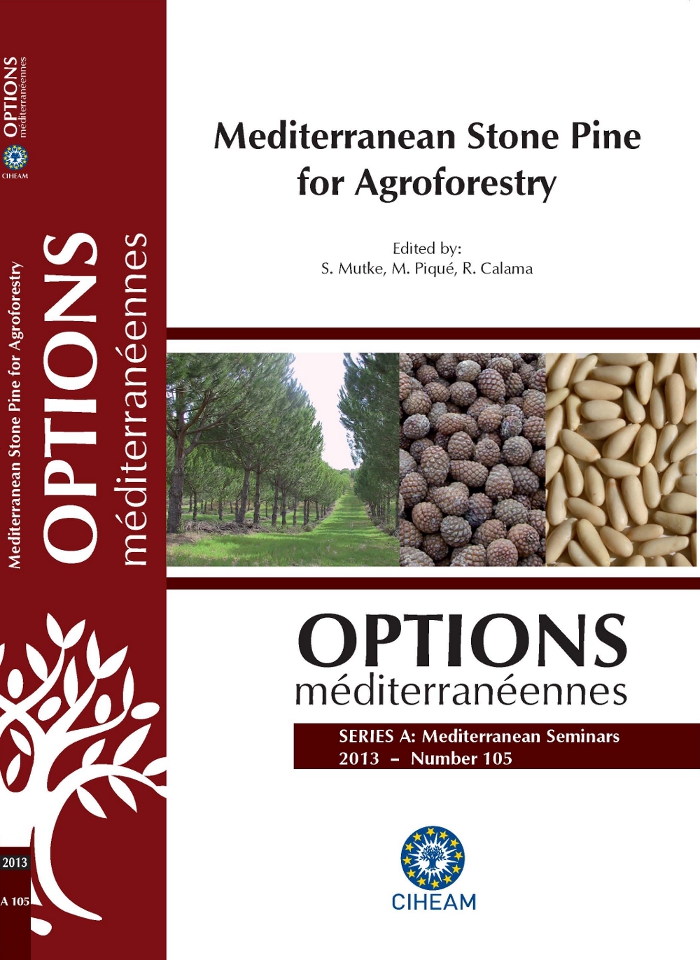| Article précédent | p. 15-19 | Article suivant |
Climate factors and their relation regarding cone yield of stone pine (Pinus pinea L.) in the Kozak Basin, Turkey
This study aims to reveal the factors that affect cone yield of both natural and planted stone pine (Pinus pinea L.) in Kozak Basin, Bergama, Izmir (Turkey). In the basin, productive and non-productive areas have been determined, according to long term observations. Topographical features of the basin, pollination properties and long term precipitation data have been analyzed. In addition, three meteorological stations have been established in places which can represent productive and non-productive areas of the basin. Productive areas have lower relative humidity and higher wind speed than non-productive areas. In nonproductive areas the number of days in which the temperature falls below -10ºC and relative humidity rates surpass 70% is higher than in productive areas. It has been determined that during pollination period a wind speed higher than 3 m/s is very effective in pollination. Likewise it is understood that pollination also is influenced negatively from precipitation occurring during pollination period, high relative humidity of air and extremely high or low temperatures. In non-productive areas it is determined that there is a temperature difference, reaching to 22ºC, between day and night. All these clues show that non-productive areas have a very similar characteristics of a typical “frost hollow (frost pocket)”.
Cette étude vise à mettre en lumière les facteurs qui influencent la production de cônes à la fois pour des pins à pignons naturels et plantés (Pinus pinea L.) dans le bassin de Kozak, Bergama, Izmir (Turquie). Dans ce bassin, on a mis en évidence des zones productives et non productives selon des observations à long terme. Les caractéristiques topographiques du bassin, les propriétés de pollinisation et les données de précipitations à long terme ont été analysées. De plus, trois stations météorologiques ont été établies dans des lieux pouvant représenter des zones productives et non productives de ce bassin. Les zones productives avaient une humidité relative plus faible et une vitesse du vent plus forte que les zones non productives. Dans les zones non productives par rapport aux zones productives, il y avait un plus grand nombre de jours où la température tombait au-dessous de -10 C0 et où les taux d'humidité relative dépassaient 70%. Il a été déterminé que pendant la période de pollinisation, une vitesse du vent supérieure à 3 m/s est très efficace pour la pollinisation. De même il est avéré que la pollinisation est également influencée négativement par des précipitations ayant lieu en période de pollinisation, par une forte humidité relative de l'air et par des températures extrêmement fortes ou faibles. Dans les zones non productives on a enregistré une différence de température, atteignant 22 0C, entre le jour et la nuit. Toutes ces pistes montrent que les zones non productives ont des caractéristiques très semblables à celles d'une “cuvette de gel" typique (ou poche de gelée)”.
- [ Afficher ]
- [ Télécharger ]
- [ Exporter la citation ]
Vous pouvez télécharger la citation au format :
- [ Imprimer ]
-
Mots-clés
FACTEUR CLIMATIQUE, FACTEUR DE PRODUCTION, FORET DE PRODUCTION, GEL, PINUS PINEA, TURQUIE, CONECiter cet article
Parlak S., Kilci M., Sayman M., Akkaş M.E., Bucak C., Boza Z. Climate factors and their relation regarding cone yield of stone pine (Pinus pinea L.) in the Kozak Basin, Turkey. In : Mutke S. (ed.), Piqué M. (ed.), Calama R. (ed.). Mediterranean stone pine for agroforestry. Zaragoza : CIHEAM / FAO / INIA / IRTA / CESEFOR / CTFC, 2013. p. 15-19. (Options Méditerranéennes : Série A. Séminaires Méditerranéens; n. 105). AGROPINE 2011 International Meeting on Mediterranean Stone Pine for Agroforestery, 2011/11/17-19, Valladolid (Spain). http://om.ciheam.org/om/pdf/a105/00006776.pdf



